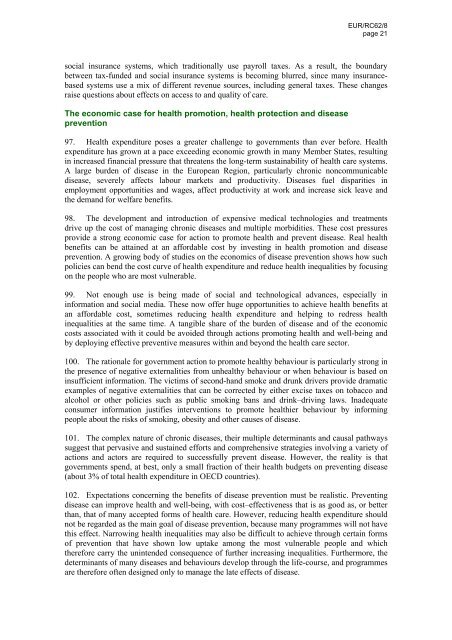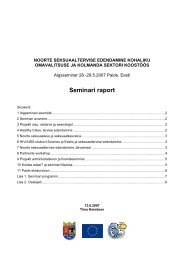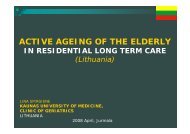EUR/RC62/wd08 (Eng) - WHO/Europe - World Health Organization
EUR/RC62/wd08 (Eng) - WHO/Europe - World Health Organization
EUR/RC62/wd08 (Eng) - WHO/Europe - World Health Organization
Create successful ePaper yourself
Turn your PDF publications into a flip-book with our unique Google optimized e-Paper software.
<strong>EUR</strong>/<strong>RC62</strong>/8<br />
page 21<br />
social insurance systems, which traditionally use payroll taxes. As a result, the boundary<br />
between tax-funded and social insurance systems is becoming blurred, since many insurancebased<br />
systems use a mix of different revenue sources, including general taxes. These changes<br />
raise questions about effects on access to and quality of care.<br />
The economic case for health promotion, health protection and disease<br />
prevention<br />
97. <strong>Health</strong> expenditure poses a greater challenge to governments than ever before. <strong>Health</strong><br />
expenditure has grown at a pace exceeding economic growth in many Member States, resulting<br />
in increased financial pressure that threatens the long-term sustainability of health care systems.<br />
A large burden of disease in the <strong>Europe</strong>an Region, particularly chronic noncommunicable<br />
disease, severely affects labour markets and productivity. Diseases fuel disparities in<br />
employment opportunities and wages, affect productivity at work and increase sick leave and<br />
the demand for welfare benefits.<br />
98. The development and introduction of expensive medical technologies and treatments<br />
drive up the cost of managing chronic diseases and multiple morbidities. These cost pressures<br />
provide a strong economic case for action to promote health and prevent disease. Real health<br />
benefits can be attained at an affordable cost by investing in health promotion and disease<br />
prevention. A growing body of studies on the economics of disease prevention shows how such<br />
policies can bend the cost curve of health expenditure and reduce health inequalities by focusing<br />
on the people who are most vulnerable.<br />
99. Not enough use is being made of social and technological advances, especially in<br />
information and social media. These now offer huge opportunities to achieve health benefits at<br />
an affordable cost, sometimes reducing health expenditure and helping to redress health<br />
inequalities at the same time. A tangible share of the burden of disease and of the economic<br />
costs associated with it could be avoided through actions promoting health and well-being and<br />
by deploying effective preventive measures within and beyond the health care sector.<br />
100. The rationale for government action to promote healthy behaviour is particularly strong in<br />
the presence of negative externalities from unhealthy behaviour or when behaviour is based on<br />
insufficient information. The victims of second-hand smoke and drunk drivers provide dramatic<br />
examples of negative externalities that can be corrected by either excise taxes on tobacco and<br />
alcohol or other policies such as public smoking bans and drink–driving laws. Inadequate<br />
consumer information justifies interventions to promote healthier behaviour by informing<br />
people about the risks of smoking, obesity and other causes of disease.<br />
101. The complex nature of chronic diseases, their multiple determinants and causal pathways<br />
suggest that pervasive and sustained efforts and comprehensive strategies involving a variety of<br />
actions and actors are required to successfully prevent disease. However, the reality is that<br />
governments spend, at best, only a small fraction of their health budgets on preventing disease<br />
(about 3% of total health expenditure in OECD countries).<br />
102. Expectations concerning the benefits of disease prevention must be realistic. Preventing<br />
disease can improve health and well-being, with cost–effectiveness that is as good as, or better<br />
than, that of many accepted forms of health care. However, reducing health expenditure should<br />
not be regarded as the main goal of disease prevention, because many programmes will not have<br />
this effect. Narrowing health inequalities may also be difficult to achieve through certain forms<br />
of prevention that have shown low uptake among the most vulnerable people and which<br />
therefore carry the unintended consequence of further increasing inequalities. Furthermore, the<br />
determinants of many diseases and behaviours develop through the life-course, and programmes<br />
are therefore often designed only to manage the late effects of disease.









